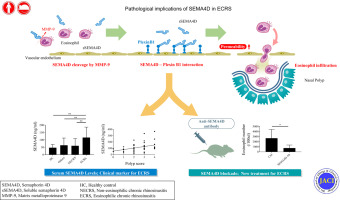当前位置:
X-MOL 学术
›
J. Allergy Clin. Immunol.
›
论文详情
Our official English website, www.x-mol.net, welcomes your
feedback! (Note: you will need to create a separate account there.)
Pathological and therapeutic implications of eosinophil-derived semaphorin 4D in eosinophilic chronic rhinosinusitis.
Journal of Allergy and Clinical Immunology ( IF 11.4 ) Pub Date : 2020-01-16 , DOI: 10.1016/j.jaci.2019.12.893 Takeshi Tsuda 1 , Masayuki Nishide 2 , Yohei Maeda 3 , Yoshitomo Hayama 4 , Shohei Koyama 2 , Satoshi Nojima 5 , Hyota Takamatsu 2 , Daisuke Okuzaki 6 , Takayoshi Morita 2 , Takeshi Nakatani 2 , Yasuhiro Kato 2 , Yoshimitsu Nakanishi 2 , Yu Futami 2 , Yasuhiko Suga 2 , Yujiro Naito 2 , Hachiro Konaka 2 , Shingo Satoh 2 , Maiko Naito 2 , Mayuko Izumi 2 , Sho Obata 1 , Ayaka Nakatani 3 , Takashi Shikina 7 , Kazuya Takeda 8 , Masaki Hayama 3 , Hidenori Inohara 3 , Atsushi Kumanogoh 9
Journal of Allergy and Clinical Immunology ( IF 11.4 ) Pub Date : 2020-01-16 , DOI: 10.1016/j.jaci.2019.12.893 Takeshi Tsuda 1 , Masayuki Nishide 2 , Yohei Maeda 3 , Yoshitomo Hayama 4 , Shohei Koyama 2 , Satoshi Nojima 5 , Hyota Takamatsu 2 , Daisuke Okuzaki 6 , Takayoshi Morita 2 , Takeshi Nakatani 2 , Yasuhiro Kato 2 , Yoshimitsu Nakanishi 2 , Yu Futami 2 , Yasuhiko Suga 2 , Yujiro Naito 2 , Hachiro Konaka 2 , Shingo Satoh 2 , Maiko Naito 2 , Mayuko Izumi 2 , Sho Obata 1 , Ayaka Nakatani 3 , Takashi Shikina 7 , Kazuya Takeda 8 , Masaki Hayama 3 , Hidenori Inohara 3 , Atsushi Kumanogoh 9
Affiliation

|
BACKGROUND
Eosinophilic chronic rhinosinusitis (ECRS) is a subtype of chronic rhinosinusitis. Clinical markers for ECRS disease activity and treatment strategies have not been sufficiently established. Although semaphorins are originally identified as neuronal guidance factors, it is becoming clear that they play key roles in immune regulation and inflammatory diseases.
OBJECTIVE
We sought to investigate the pathological functions and therapeutic potential of semaphorin 4D (SEMA4D) in ECRS.
METHODS
Serum soluble SEMA4D levels in patients with paranasal sinus diseases were measured by ELISA. The expression of SEMA4D in blood cells and nasal polyp tissues was assessed by flow cytometry and immunohistochemistry, respectively. Generation of soluble SEMA4D was evaluated in matrix metalloproteinase-treated eosinophils. Endothelial cells were stimulated with recombinant SEMA4D, followed by eosinophil transendothelial migration assays. Allergic chronic rhinosinusitis was induced in mice using Aspergillus protease with ovalbumin. The efficacy of treatment with anti-SEMA4D antibody was evaluated histologically and by nasal lavage fluid analysis.
RESULTS
Serum soluble SEMA4D levels were elevated in patients with ECRS and positively correlated with disease severity. Tissue-infiltrated eosinophils in nasal polyps from patients with ECRS stained strongly with anti-SEMA4D antibody. Cell surface expression of SEMA4D on eosinophils from patients with ECRS was reduced, which was due to matrix metalloproteinase-9-mediated cleavage of membrane SEMA4D. Soluble SEMA4D induced eosinophil transendothelial migration. Treatment with anti-SEMA4D antibody ameliorated eosinophilic infiltration in sinus tissues and nasal lavage fluid in the ECRS animal model.
CONCLUSIONS
Eosinophil-derived SEMA4D aggravates ECRS. Levels of serum SEMA4D reflect disease severity, and anti-SEMA4D antibody has therapeutic potential as a treatment for ECRS.
中文翻译:

嗜酸性粒细胞慢性信号鼻窦炎中嗜酸性粒细胞衍生信号蛋白4D的病理学和治疗意义。
背景技术嗜酸性慢性鼻-鼻窦炎(ECRS)是慢性鼻-鼻窦炎的一种亚型。ECRS疾病活动和治疗策略的临床指标尚未充分建立。尽管信号量最初被确定为神经元指导因素,但越来越清楚的是,它们在免疫调节和炎症性疾病中起关键作用。目的我们试图研究ECRS中semaphorin 4D(SEMA4D)的病理功能和治疗潜力。方法采用酶联免疫吸附法(ELISA)检测鼻旁窦疾病患者的血清可溶性SEMA4D水平。通过流式细胞术和免疫组织化学分别评估SEMA4D在血细胞和鼻息肉组织中的表达。在基质金属蛋白酶处理的嗜酸性粒细胞中评估了可溶性SEMA4D的产生。用重组SEMA4D刺激内皮细胞,然后进行嗜酸性粒细胞跨内皮迁移试验。使用带有卵白蛋白的曲霉蛋白酶在小鼠中诱发过敏性慢性鼻-鼻窦炎。通过组织学和鼻灌洗液分析评估了抗SEMA4D抗体的治疗效果。结果ECRS患者的血清可溶性SEMA4D水平升高,并且与疾病严重程度呈正相关。ECRS患者鼻息肉中组织浸润的嗜酸性粒细胞被抗SEMA4D抗体强烈染色。ECRS患者嗜酸性粒细胞上SEMA4D的细胞表面表达降低,这是由于基质金属蛋白酶9介导的SEMA4D膜裂解所致。可溶性SEMA4D诱导嗜酸性粒细胞跨内皮迁移。在ECRS动物模型中,抗SEMA4D抗体的治疗可改善鼻窦组织和鼻灌洗液中的嗜酸性粒细胞浸润。结论嗜酸性粒细胞来源的SEMA4D加重了ECRS。血清SEMA4D的水平反映了疾病的严重程度,抗SEMA4D抗体具有治疗ECRS的潜力。
更新日期:2020-02-06
中文翻译:

嗜酸性粒细胞慢性信号鼻窦炎中嗜酸性粒细胞衍生信号蛋白4D的病理学和治疗意义。
背景技术嗜酸性慢性鼻-鼻窦炎(ECRS)是慢性鼻-鼻窦炎的一种亚型。ECRS疾病活动和治疗策略的临床指标尚未充分建立。尽管信号量最初被确定为神经元指导因素,但越来越清楚的是,它们在免疫调节和炎症性疾病中起关键作用。目的我们试图研究ECRS中semaphorin 4D(SEMA4D)的病理功能和治疗潜力。方法采用酶联免疫吸附法(ELISA)检测鼻旁窦疾病患者的血清可溶性SEMA4D水平。通过流式细胞术和免疫组织化学分别评估SEMA4D在血细胞和鼻息肉组织中的表达。在基质金属蛋白酶处理的嗜酸性粒细胞中评估了可溶性SEMA4D的产生。用重组SEMA4D刺激内皮细胞,然后进行嗜酸性粒细胞跨内皮迁移试验。使用带有卵白蛋白的曲霉蛋白酶在小鼠中诱发过敏性慢性鼻-鼻窦炎。通过组织学和鼻灌洗液分析评估了抗SEMA4D抗体的治疗效果。结果ECRS患者的血清可溶性SEMA4D水平升高,并且与疾病严重程度呈正相关。ECRS患者鼻息肉中组织浸润的嗜酸性粒细胞被抗SEMA4D抗体强烈染色。ECRS患者嗜酸性粒细胞上SEMA4D的细胞表面表达降低,这是由于基质金属蛋白酶9介导的SEMA4D膜裂解所致。可溶性SEMA4D诱导嗜酸性粒细胞跨内皮迁移。在ECRS动物模型中,抗SEMA4D抗体的治疗可改善鼻窦组织和鼻灌洗液中的嗜酸性粒细胞浸润。结论嗜酸性粒细胞来源的SEMA4D加重了ECRS。血清SEMA4D的水平反映了疾病的严重程度,抗SEMA4D抗体具有治疗ECRS的潜力。











































 京公网安备 11010802027423号
京公网安备 11010802027423号